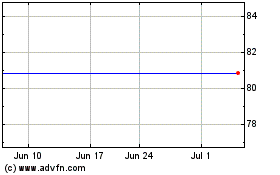Medtronic Tissue-Freezing Balloon Tops Drugs In Study
March 15 2010 - 8:29AM
Dow Jones News
A Medtronic Inc. (MDT) catheter with a balloon that freezes
heart tissue to treat a common rhythm disorder outperformed
medication in a study the company is using to try and gain access
to the U.S. market.
The company's tool caused some nerve impairment that isn't
typical with heat-based catheters, but this rarely caused a lasting
problem, according to a study investigator. The Medtronic-funded
"Stop AF" study met its primary safety and effectiveness goals.
One-year results, examining Medtronic's Arctic Front device as a
treatment for atrial fibrillation, or AF, were set for presentation
early Monday at the American College of Cardiology's annual
conference.
Medtronic aims to ramp up its presence in the small but
fast-growing market for catheter-based treatment of AF, which is
the most common type of arrhythmia, affecting about 2.2 million
Americans. It involves quivering in the heart's upper chambers and
is linked to heightened stroke risk.
The catheter-based treatment market is worth about $550 million
to $600 million, Leerink Swann estimated, so this technology won't
have a major impact for Medtronic, which posted revenue of $14.6
billion in its last fiscal year. Still, the market grows faster
than Medtronic's core business for implantable pacemakers and
defibrillators.
Wells Fargo analyst Larry Biegelsen thinks this technology could
contribute about $200 million in 2012 sales for Medtronic. The
company has already filed a Food and Drug Administration
application and sees potential Arctic Front approval in the first
half next year. The tool is on sale already in Europe.
Drugs are the first-line AF treatment, but are frequently
ineffective and can have tough side effects. Another alternative is
using catheters threaded through blood vessels to burn tissue and
disrupt electrical signals behind the disorder. This for years was
done with tools approved for other uses, since Johnson &
Johnson's (JNJ) Biosense Webster became the first company to gain
specific AF approval from the Food and Drug Administration just
last year.
St. Jude Medical Inc. (STJ) and Boston Scientific Corp. (BSX)
also compete in the market.
Medtronic's tool freezes tissue with a small balloon, rather
than burning with a catheter point. The company is aiming this
technology at AF that starts and stops on its own and is linked to
electrical signals where pulmonary veins attach to the heart.
In Stop AF, which featured 245 patients, 70% of those treated
with Medtronic's device remained free of AF at one year, compared
to 7.3% on drug therapy.
Kevin Wheelan, study investigator and chief of staff at Baylor
Heart and Vascular in Dallas, noted that drugs performed
surprisingly poorly. He has financial ties to Medtronic and other
device companies through consulting and other work.
The key question is whether Medtronic's device performed well
enough, and safely enough, to carve a niche among heat-based
devices. Leerink Swann analyst Rick Wise said a lack of clinical
data for this market makes it tough to measure success. Balloon
procedures could expand the market if they prove easier, analysts
said.
The balloon system is "a simpler, less technically demanding
procedure than the point-by-point catheter," Wheelan said in an
interview.
On the safety front, the 11% rate of impairment to the phrenic
nerve seen among Arctic Front-treated patients "is an issue one has
to be aware of," Wheelan added. This issue is much less common with
heat-based catheters, although the points on those devices pose a
risk for perforation.
Seven of 228 patients treated with Medtronic's device had
narrowing in a vein after an Arctic Front procedure, and one needed
another procedure to widen the vein.
Medtronic bought this technology through a $380 million
acquisition in late 2008. It also made a small deal in early 2009
for a company making a heat-based catheter system aimed at a
different type of AF.
-By Jon Kamp, Dow Jones Newswires; 617-654-6728;
jon.kamp@dowjones.com
SJM (NYSE:STJ)
Historical Stock Chart
From Jun 2024 to Jul 2024

SJM (NYSE:STJ)
Historical Stock Chart
From Jul 2023 to Jul 2024
